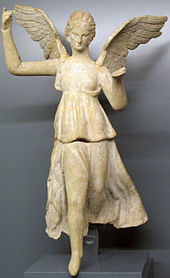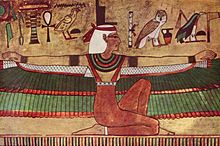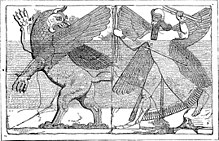Angel
![]()
The title of this article is ambiguous. For other meanings, see Angel (disambiguation).
Angel (Latin angelus, Gothic angilus; from ancient Greek ἄγγελος ángelos "messenger", "emissary". Translation of Hebrew מלאך mal'ach "messenger, envoy; message, mission; Maleach" - cf. also "Gospel" and "Malik" as well as "Moloch") is a generic name for heavenly beings (spirit beings). Angels are in the teachings of the monotheistic Abrahamic religions of Judaism, Christianity and Islam spirit beings in (winged) human form, which were created by God, are subordinate to him and act as his messengers to mankind.
The spiritual understanding of angels and their function and order is largely taken from the Tanakh, the New Testament and the Koran. In addition to the writings of the biblical canon, late antique and medieval legends of saints, homilies, miracle stories and popular narrative material such as sagas and fairy tales were among the sources for the ideas of angels. These are also widespread in esotericism.
The idea of a spiritual being alongside the main god or goddesses is a cultural asset that has been handed down over the ages in the Near Eastern cultural area. In the mythographies of Babylonia and in the sacred writings of Zoroastrianism, similar mediators between the deity and the world can be found. Pictorial representations usually show angels as winged beings. Mythical winged hybrid beings in the Persian Empire and the depiction of ancient Egyptian deities show beings belonging to the sacred divine sphere. In such religions, angelic beings are therefore not full gods, but belong to the category of demi-deities.
Sometimes also in polytheistic religions godlike, but not divine beings, who can convey the supernatural, are translated or compared with "angels", e.g. Deva as well as other - wingless - Indian demigods and deities. In common usage, however, "angels" are understood to be messengers of the one God of one of the monotheistic views.

Andrei Rublev's Trinity icon Troiza - Abraham's banquet with the three angels in Mamre (c. 1425)

The archangel Gabriel appears to Zacharias. Illustration from The Book of Hours of the Duke of Berry (1410-1489)
Antecedent
Persia and Zoroastrianism
In Zoroastrianism, originally the most widespread religion in the Persian Empire, Yazata are assistants attached to the supreme deity or touched with his divine spark. Malakhim are messengers of God's moral will to mankind.
The concept of such God-sent helpers may have entered Judaism during the Babylonian exile in the course of intellectual analysis of a way to God. Pictorial representations of winged divine beings are known through contacts of Persian with Greek and Roman culture.
Mesopotamia and Ancient Egypt
The description of winged, divine or god-like beings such as Nephtys in the ancient Egyptian myths surrounding Isis and Osiris (Osiris myth) could be an origin of the depiction of angels.
The concept of winged beings as mediators between gods and humans is also found in the cultures of Mesopotamia. Winged deities or guardian genii appear in the iconography of the religions of Mesopotamia. "Angelic" representations are found, for example, in the royal palaces of the Babylonians or Assyrians in Nineveh, Nimrud, or Dur Sharrukin.
Greek and Roman Antiquity
In Greek mythology, the Daimones appear as personal guardian spirits and intermediaries between gods and humans. According to Hesiod, they emerged from the souls of the people of the Golden Age. The Greek daimon corresponds to the Roman genius, who can also be represented as winged. But also the gods themselves intervene in the lives of men or send the messenger of the gods Hermes-Mercurius, who wears winged shoes and hat as attributes. With the confrontation of Greece with oriental, especially Persian culture, the idea of Nike, the goddess of victory, winged with bird's wings, entered Olympus. As Victoria, she also entered the Roman cultural sphere and was later stylized as an angel of victory with a victory wreath and palm branch. Despite such parallels, the Greco-Roman world of the gods probably had little influence on the understanding of angels in classical antiquity, which largely retained its direct reference to the ideas of angels in the Orient until Christianisation in the European cultural area or Islamisation in the Arab region. In the Renaissance, scholars such as Marsilio Ficino related the ancient tradition of genii/Daimones to the Christian concept of the guardian angel.

Nike, 2nd-1st century BC.

Isis with winged arms. Mural in the tomb (KV17) of Sethos I in the Valley of the Kings (c. 1360 B.C.)

Winged Assyrian deity: Ninurta fights with a bird monster. Drawing from a stone relief on the temple of the god at Nimrud (9th century BC).
Angels in Judaism
Angels, Hebrew מלאך mal'ach "messengers", are understood in Judaism by interpretation of the Tanakh and in long tradition mostly as supernatural beings who stand by God in heaven, but are to be strictly distinguished from and subordinate to God (YHWH). They may occasionally make God's will and instructions known to selected people. They are also subordinate to humans in the Jewish tradition, as they have no will of their own and are only capable of carrying out a divine command at a time.
The appearance of angels already plays a major role in the tradition of the early history of the people of Israel. Understanding of angels moves with tradition and enters into the other Abrahamic religions. However, in the Jewish belief in celestial beings, the complex explanation of their spiritual world is not governed by a precisely definable scheme of order, as, for example, the angelology of early Christianity then seeks to establish.
The angels, according to Rabbinical Judaism, have no body, but are eternal living creatures made of fire, and occasionally appear in Midrashim as rivals to man. The heavenly beings, strictly following the laws of God, become jealous of God's affection towards man. Man, they say, is favored by following the Torah, in prayer, resisting the evil impulse (jetzer ha-rah), and by teshuba, the already spotless angels. Thus, in Jewish tradition, they also stand among men. In the Midrash, the plural used in Genesis in reference to the creation of man is explained by the presence of angels: according to this, God consulted with the angels, but finally decided alone. The story serves as a model for man; even the mighty should consult with the weak. God's own decision represents God's sole omnipotence.
Questions and Answers
Q: What is an angel?
A: An angel is a good spirit that is considered a messenger in various mythologies and religions.
Q: What is the origin of the word angel?
A: The word angel originates from the Greek word "angelos" which means "messenger".
Q: In what religious texts do angels appear frequently?
A: Angels appear frequently in the Old Testament, the New Testament, Qur'an and Aqdas.
Q: Are there different kinds and ranks of angels?
A: Yes, different references to angels throughout the Bible suggest different kinds and ranks of angels, such as seraphs or cherubs.
Q: What hierarchy of divine messengers did medieval theologians outline?
A: Medieval theologians outlined a hierarchy of divine messengers, including not only cherubs or cherubim (the Hebrew plural) and seraphim, but also archangels, powers, principalities, dominions and thrones.
Q: What is the study of angels called?
A: The study of angels is called Angelology.
Q: Are angels considered bad spirits?
A: No, angels are considered to be good spirits.
Search within the encyclopedia